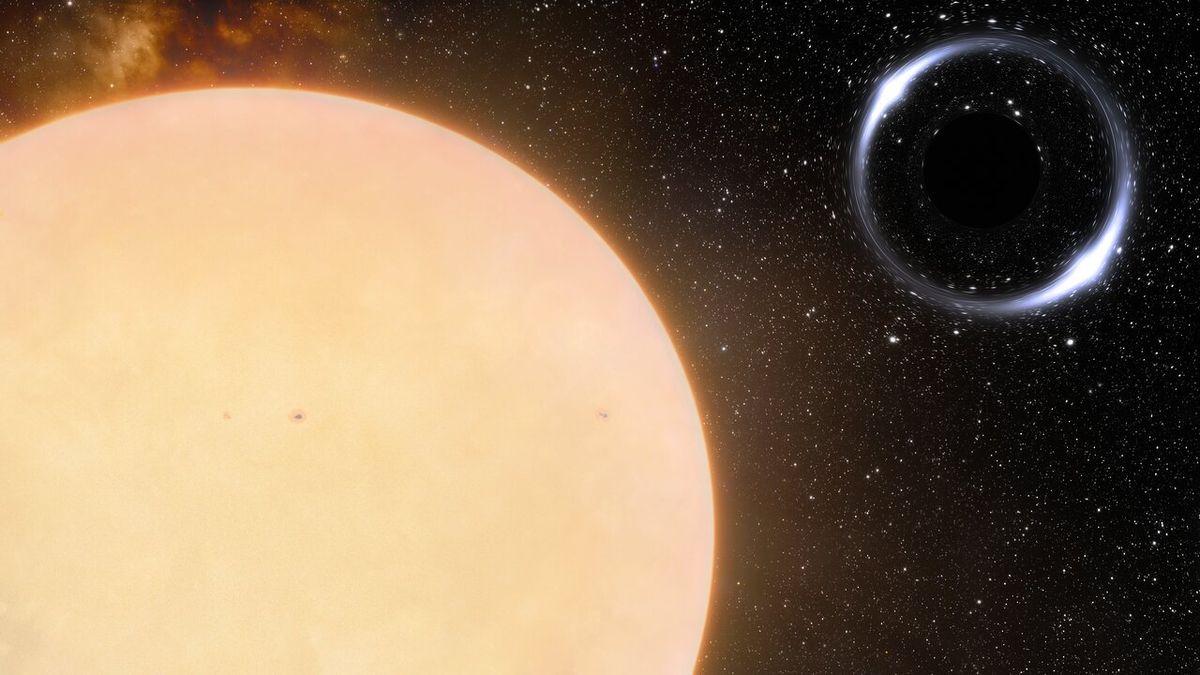Table of Contents
- Exploring the Mysteries of Gaia BH1 Black Hole
- The Formation and Evolution of Gaia BH1
- Understanding the Impact of Gaia BH1 on Surrounding Celestial Bodies
- Innovations in Black Hole Research: What Gaia BH1 Reveals
- Future Observations and Research Recommendations for Gaia BH1
- Q&A
- Concluding Remarks

Exploring the Mysteries of Gaia BH1 Black Hole
The discovery of Gaia BH1 has ushered in a new era of astrophysical exploration, captivating scientists and enthusiasts alike. Nestled within our galaxy, this black hole stands out not just for its size but for the surrounding mysteries it presents. With an estimated mass of around 10 solar masses, Gaia BH1 is classified as a stellar black hole, likely formed from the remnants of a massive star that underwent supernova. This process leads to a core collapse, leaving behind a gravitational powerhouse that warps the very fabric of spacetime.
One of the most intriguing aspects of Gaia BH1 is its relatively close proximity to Earth—approximately 1,560 light-years away in the constellation Ophiuchus. This closeness provides astronomers with a unique opportunity to study its characteristics in unprecedented detail. The black hole’s presence has implications for our understanding of cosmic evolution and the lifecycle of stars. Several questions arise about its formation and whether similar stellar masses are common in the universe. The ongoing research includes:
- Analyzing gravitational wave signals from potential mergers associated with Gaia BH1.
- Observing surrounding luminescent materials that may provide insight into accretion processes.
- Studying the velocity of nearby stars to ascertain the influence of Gaia BH1 on its galactic environment.
Researchers utilize advanced observational techniques and cutting-edge technology, including the European Space Agency’s Gaia spacecraft, to unravel the black hole’s characteristics. Notably, the study of Gaia BH1 contributes to a broader understanding of the dark matter question, as scientists hypothesize about the relationship between dark matter and black holes. The interplay between these cosmic mysteries offers the potential for groundbreaking discoveries and may reshape our understanding of the universe’s vast, hidden sectors.

The Formation and Evolution of Gaia BH1
Gaia BH1 is not merely a black hole; it represents a groundbreaking discovery in our understanding of stellar evolution. This enigmatic object is positioned within a complex cosmic dance, evolving from a massive star that exhausted its nuclear fuel. The lifecycle of such stars follows a well-defined path through various phases of development, leading them ultimately to a cataclysmic end. When the star’s core collapses, an energetic supernova explosion leaves behind either a neutron star or a black hole. Gaia BH1 is a prime candidate that evolved from this pathway, expanding our knowledge about the fate of massive stars in the universe.
The observation of Gaia BH1 sheds light on the environments that contribute to black hole formation. Evidence suggests that the black hole is located within a star cluster, providing key insights into how the surrounding matter influences its growth and stability. The environment surrounding Gaia BH1 can be characterized by:
- High-density stellar populations
- Dynamic gravitational interactions
- Potential for mergers with other stellar objects
Delving deeper, researchers are analyzing the characteristics of Gaia BH1 through advanced astrometric measurements. By mapping the movement and gravitational effects of nearby stars, scientists can infer the black hole’s mass and influence on its surroundings. Key metrics for understanding Gaia BH1’s characteristics include:
| Metric | Value |
|---|---|
| Mass | ~10 solar masses |
| Distance from Earth | ~1,600 light-years |
| Orbital speed of nearby stars | Varies, high velocity |

Understanding the Impact of Gaia BH1 on Surrounding Celestial Bodies
Gaia BH1, a stellar-mass black hole located approximately 1,600 light-years away, is a fascinating subject of study in the realm of astrophysics. Its discovery has opened up new avenues for understanding how such objects affect nearby celestial bodies. The gravitational influence of this black hole significantly alters the dynamics of its environment, leading to a host of intriguing phenomena. For instance, stars within a certain radius experience gravitational perturbations, which can result in:
- Changes in Orbital Paths: Stars that venture too close to Gaia BH1 may have their orbits altered, potentially leading to ejections or collisions with other stellar systems.
- Acceleration of Cosmic Matter: The accretion of surrounding gas and dust into Gaia BH1 generates high-energy jets that can impact nearby celestial formations.
- Repositioning of Stellar Neighborhoods: Over time, the gravitational pull of Gaia BH1 could lead to shifting constellations and the formation of new star clusters.
The interactions between Gaia BH1 and its neighboring stellar entities are not solely detrimental. In fact, they can contribute to the birth of new astronomical phenomena. As stars traverse the gravitational landscape shaped by Gaia BH1, some may experience increased stellar activity, leading to:
- Enhanced Stellar Formation: The gravitational interactions can compress nearby gas clouds, potentially triggering new star formation.
- Variability in Luminosity: Stellar systems may manifest increased brightness due to gravitational lensing effects caused by the black hole.
Understanding these impacts not only sheds light on the behavior and lifecycle of stars but also provides insights into the larger structure of our galaxy. The study of Gaia BH1 exemplifies the profound interconnectedness of celestial bodies. Tracking the movements and interactions of surrounding stars can reveal valuable information about:
| Aspect | Effect of Gaia BH1 |
|---|---|
| Orbital Dynamics | Alteration of trajectories |
| Stellar Activity | Increased brightness and variability |
| Star Formation | Triggering of new stars from gas clouds |

Innovations in Black Hole Research: What Gaia BH1 Reveals
The discovery of Gaia BH1 marks a significant leap forward in our understanding of black holes and their formation. Utilizing data from the Gaia space observatory, astronomers have identified this black hole as the closest known to Earth, located approximately 1,560 light-years away. This proximity allows researchers to analyze its characteristics in unprecedented detail, providing insights into the behaviors and properties of black holes in our galaxy. Key aspects of Gaia BH1 that stand out include its mass, which has been gauged to be around 10 times that of our Sun, and its unique horizontal orbital path that deviates from conventional stellar movements.
The research surrounding Gaia BH1 suggests compelling implications for stellar evolution theories. Traditional understanding posits that black holes form from the remnants of massive stars, but the discovery of this black hole raises questions about the processes at work in the less dense regions of the Milky Way. Notably, Gaia BH1 appears to be a part of a binary system, suggesting that interactions between stars may also play a crucial role in black hole formation. This opens the door to several avenues for further research, and scientists are motivated to explore these possibilities through upcoming observational campaigns.
| Feature | Details |
|---|---|
| Distance | 1,560 light-years |
| Mass | 10 Solar masses |
| Type | Stellar |
| System | Binary |
The implications of Gaia BH1 extend beyond mere discovery; they challenge and refine our mathematical models of cosmic formations. With each new observation, scientists gain vital information that could alter the landscape of astrophysics. The ongoing analysis of Gaia BH1 not only enhances our knowledge of black holes but can also shed light on dark matter and the overall dynamics of galactic structures. This landmark finding emphasizes the importance of continued investment in space exploration and the tools necessary to unravel the mysteries of the universe.

Future Observations and Research Recommendations for Gaia BH1
As researchers continue to unravel the mysteries surrounding Gaia BH1, future observations should focus on enhancing the precision of mass measurements and characterizing its host star. The Gaia spacecraft, equipped with its cutting-edge astrometry capabilities, can provide invaluable data on the black hole’s motion and gravitational influence on nearby celestial bodies. To achieve this, key strategies should include:- Utilizing long-term photometric monitoring to detect any changes in the brightness of companion stars.
- Employing spectroscopic analysis to better understand the chemical compositions and velocities of nearby stars influenced by Gaia BH1.
- Implementing advanced data-processing algorithms to maximize the information gleaned from Gaia’s observations, thus improving the accuracy of parameters such as distance and mass.
- Developing detailed simulations of Gaia BH1’s formation to understand its origins better.
- Studying the interactions between Gaia BH1 and potential accretion disks or stellar remnants.
- Exploring theoretical models that predict the effects of Gaia BH1 on local cosmic structures and its role within the Milky Way.



0 Comments